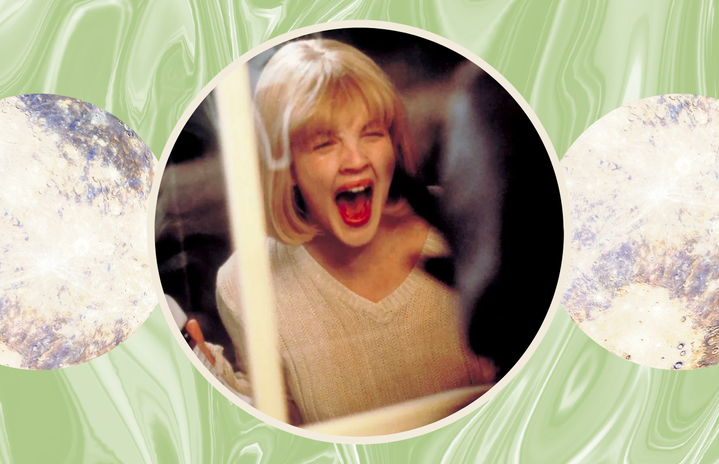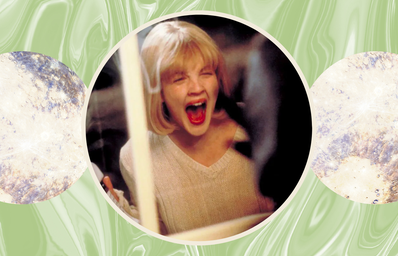“She is literally me!” I said to my friends as I left the UCSB ASBP’s showing of Midsommar.
The “she” I was referring to is Dani Ardor, the main character of Midsommar, a daylight folk-horror movie in which Dani and her boyfriend, Christian, visit their friend’s hometown in Sweden (a commune belonging to a Pagan cult). Dani ends up sacrificing Christian (who is a selfish and gaslighting cheater) after becoming May Queen during the cult’s Midsummer festivities, to the praise of literally everyone who has seen the movie.
Midsommar is one of the few film portrayals of a woman who doesn’t allow herself to be mistreated, and lets herself feel anger, sadness, and grief in its full capacity — explaining all the girlies and I were always rooting for her. Dani Ardor is one of many iconic horror heroines who fit into the “crazy, unhinged woman” archetype.
The crazy, unhinged woman is reckless, chaotic, and angry — the antithesis of the “clean girl” or the “it girl.” Her very existence repulses men and rejects beauty standards. But more than anything, the crazy, unhinged woman is beloved. Here are my two favorite unhinged women along with my thoughts on feminine rage and its reclamation.

Pearl
Pearl, in the A24 movie Pearl, is a farmgirl who has to care for her sick father under the command of a controlling mother. Her life is anything but pastoral and idyllic — she longs for a better life as a showgirl where she can finally be appreciated. You may have heard her TikTok viral “Please, I’m a star!” monologue, where she begs the judges of an audition to reconsider her even though she is not a “blonde, all-American” girl. And, of course, she goes on a killing spree, murdering her entire family before going back to her sad, provincial life.
Murder aside, Pearl embodies female yearning — not for a person necessarily, but for a feeling — to be loved, to be appreciated, to get rid of the pit in her stomach that tells her there’s something better than this. Although I’m not a rural farmgirl with dreams to gyrate in an early-1900’s dress, Pearl’s longing for something better is wholly relatable. To be a woman is to chase and hope, and no matter how much I chase, I’m still terribly behind.
Amy Dunne
Amy Dunne of Gone Girl seemingly lives the “good life:” she’s married to a loving husband and recently moved to the beautiful Missouri suburbs to be closer to her husband’s family. Behind closed doors, however, everything is falling apart: she resents her husband for uprooting their life in New York, she knows about his affair with a younger student, and she is in the process of orchestrating her disappearance to get away from her life.
Analyzed to shreds in feminist Internet spaces, Amy Dunne’s satirical and highly controversial “Cool Girl Monologue” explores society’s expectation for women to be “cool,” to “like everything he likes and not complain.” In relation to her relationship with her husband, everything mentioned in the “Cool Girl Monologue” is the basis for her faking her disappearance — she is tried of pretending to be someone she isn’t, tired of “adoring football, poker… and cheap beer,” and tired of smiling in a “chagrined, loving manner” instead of standing up for herself.
And isn’t that what most women feel at least once in their lives? Our existence is followed by a magnifying glass, picking apart everything wrong with us. We learn to move to the side and stick to the corner when there’s foot traffic, we learn to say “I’m so sorry!” when people bump into us, we learn to exist for others, not for ourselves. Every girl and woman I know has had their own version of the “Cool Girl Monologue.”
Final Thoughts
Upon compiling this (small) list, I’ve noticed that my favorite “crazy, unhinged women,” along with many “crazy and unhinged” female characters are from the horror and thriller genre. Why is it that the only female characters representing raw, unfiltered women are horrible villains, killers, cannibals, and psychopaths?
As much as I am an apologist for all the aforementioned “crazy girls,” it’s disheartening that most of the time, women in film who reject societal standards and expectations are villains or generally unlikeable characters. As much as we want to deny it, female rage, a unique type of anger felt by women in response to injustice, is villainized in media (i.e. film and TV, not the news, for the purpose of this article).
Being angry with the way you’re being treated as a woman is not shameful. It does not make you “the problem.” You are not crazy or unhinged. So until there are beautiful, true depictions of female rage where a woman character isn’t the “bad guy,” I’m going to reclaim “crazy and unhinged” woman horror and thriller characters as feminist icons.

